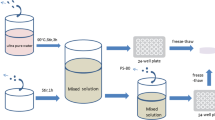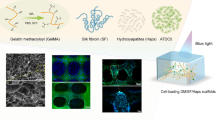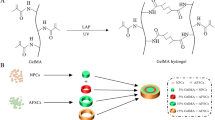Summary
KLD-12 peptide with a sequence of AcN-KLDLKLDLKLDL-CNH2 was synthesized and its biocompatibility was assessed in animals. Rabbit MSCs were cultured in the hydrogel for 2 weeks. Live cells were counted by using Calcein-AM/PI fluorescence staining. MTT was employed to assess the viability of MSCs cultured in KLD-12 peptide solution of 0.01%, 0.03%, and 0.05%. Hemolysis test, skin irritation test and implantation test were conducted to evaluate its biocompatibility with host tissues. Our results demonstrated that the MSCs in hydrogel grew well and maintained round shape. Cell survival rate was 92.15% (mean: 92.15%±1.17%) at the 7th day and there was no difference in survival rate between day 7 and day 14. Cell proliferation test showed that the A value of the KLD-12 solutions was not significantly different from that of control groups (complete culture media) (P>0.05) at the 24th and 48th h. The hemolysis rate of KLD-12 solution was 0.112%. Skin irritation test showed that the skin injected with KLD-12 solution remained normal and the score of skin irritation was 0. The histological examination with HE staining exhibited that the skin layers were clear and there was no infiltration with neutrophilic granulocytes and lymphocytes. It is concluded that KLD-12 peptide hydrogel had a good biocompatibility with host rabbit and MSCs, and KLD-12 peptide hydrogel can provide an appropriate microenvironment for MSCs.
Similar content being viewed by others
References
Buckwalter JA. Aging and degeneration of the human ntervertebral disc. Spine, 1995,20(11):1307–1314
Gan J C, Ducheyne P, Vresilovic EJ, et al. Intervertebral disc tissue engineering I: characterization of the nucleus pulposus. Clin Orthop Relat Res, 2003,7(411):305–314
Gruber HE, Hanley EN Jr. Analysis of aging and degeneration of the human intervertebral disc: Comparison of surgical specimens with normal controls. Spine, 1998, 23(7):751–757
Rannou F, Lee TS, Zhou RH, et al. Intervertebral disc degeneration: the role of the mitochondrial pathway in annulus fibrosus cell apoptosis induced by overload. Am J Pathol, 2004,164(3):915–924
Lehmann TR, Spratt KF, Tozzi JE, et al. Long-term follow-up of lower lumbar fusion patients. Spine, 1987, 12(2):97–104
Jullig M, Zhang WV, Stott NS. Gene therapy in orthopaedic surgery: the current status. ANZJ Surg, 2004, 74(1–2):46–54
Kisiday J, Jin M, Kurz B et al. Self-assembling peptide hydrogel fosters chondrocyte extracellular matrix production and cell division: implications for cartilage tissue repair. Proc Natl Acad Sci USA, 2002,99(15): 9996–10001
Sun JH, Zheng QX. Experimental study on self-assembly of KLD-12 peptide hydrogel and 3-D culture of MSC encapsulated within hydrogel in vitro. J Huazhong Univ Sci Technol [Med Sci], 2009,29(4):645–648
Risbud MV, Albert TJ, Guttapalli A, et al. Differentiation of mesenchymal stem cells towards a nucleus pulposuslike phenotype in vitro: implications for cell-based transplantation therapy. Spine, 2004,29(23):2627–2632
Zheng QX, Liu SN. The preparation of sintered bovine cancellous bone and a study of its mechanical and chemical behavior and biocompatibility. J Biomed Eng, 2005,22(1):95–98
Gruber HE, Ingram JA, Leslie K, et al. Cell shape and gene expression in human intervertebral disc cells: in vitro tissue engineering studies. Biotech Histochem, 2003, 78(2):109–117
Gruber HE, Hanley EN Jr. Biologic strategies for the therapy of intervertebral disc degeneration. Expert Opin Biol Ther, 2003,3(8):1209–1214
Leung VY, Chan D, Cheung KM. Regeneration of intervertebral disc by mesenchymal stem cells: potentials, limitations, and future direction. Eur Spine J, 2006, 15(Suppl 3):S406–S413
Sakai D, Mochida J. Stem cell application in cell therapy for nucleus repair. Eur Cell Mater, 2005,10( Suppl 3):43
Thonar E, An H, Masuda K. Compartmentalization of the matrix formed by nucleus pulposus and annulus fibrosus cells in alginate gel. Biochem Soc Trans, 2002,30(Pt 6): 874–878
Chiba K, Andersson GB, Masuda K, et al. A new culture system to study the metabolism of the intervertebral disc in vitro. Spine, 1998,23(17):1821–1827
Alini M, Li W, Markovic P, et al. The potential and limitations of a cell-seeded collagen/hyaluronan scaffold to engineer an intervertebral disc-like matrix. Spine, 2003, 28(5):446–453
Sato M, Asazuma T, Ishihara M, et al. An experimental study of the regeneration of the intervertebral disc with an allograft of cultured annulus fibrosus cells using a tissue-engineering method. Spine, 2003,28(6):548–553
Sato M, Asazuma T, Ishihara M, et al. An atelocollagen honeycomb-shaped scaffold with a membrane seal (ACHMS-scaffold) for the culture of annulus fibrosus cells from an intervertebral disc. J Biomed Mater Res A, 2003,64(2):248–256
Sato M, Kikuchi M, Ishihara M, et al. Tissue engineering of the intervertebral disc with cultured annulus fibrosus cells using atelocollagen honeycomb-shaped scaffold with a membrane seal (ACHMS scaffold). Med Biol Eng Comput, 2003,41(3):365–371
Neidlinger-Wilke C, Wurtz K, Liedert A, et al. A three-dimensional collagen matrix as a suitable culture system for the comparison of cyclic strain and hydrostatic pressure effects on intervertebral disc cells. J Neurosurg Spine, 2005,2(4):457–465
Sebastine IM, Williams DJ. Current developments in tissue engineering of nucleus pulposus for the treatment of intervertebral disc degeneration. Conf Proc IEEE Eng Med Biol Soc, 2007,2007:6401–6406
Steck E, Bertram H, Abel R, et al. Induction of intervertebral disc-like cells from adult mesenchymal stem cells. Stem Cells, 2005,23(3):403–411
Sobajima S, Vadala G, Shimer A. Feasibility of a stem cell therapy for intervertebral disc degeneration. Spine, 2008, 8(6):888–896
Le Maitre CL, Baird P, Freemont AJ, et al. An in vitro study investigation the survival and phenotype of mesenchymal stem cells following injection into nucleus pulposus tissue. Arthritis Res Ther, 2009,11(1):R20
Author information
Authors and Affiliations
Corresponding author
Additional information
This project was supported by a grant from the National High Technology Research and Development Program of China (Program 863) (No. 2006AA02A124).
Rights and permissions
About this article
Cite this article
Sun, J., Zheng, Q., Wu, Y. et al. Biocompatibility of KLD-12 peptide hydrogel as a scaffold in tissue engineering of intervertebral discs in rabbits. J. Huazhong Univ. Sci. Technol. [Med. Sci.] 30, 173–177 (2010). https://doi.org/10.1007/s11596-010-0208-z
Received:
Published:
Issue Date:
DOI: https://doi.org/10.1007/s11596-010-0208-z




